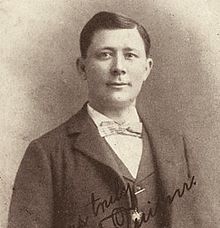Dan W. Quinn
| Dan W. Quinn | |
|---|---|
 |
|
| Background information | |
| Birth name | Dan W. Quinn |
| Born | November 1860 New York, New York |
| Died | November 7, 1938 New York, New York |
| Genres | Ragtime |
| Occupation(s) | Recording artist |
Dan W. Quinn (November 1860 – November 7, 1938) was one of the first American singers to become popular in the new medium of recorded music. Quinn was a very successful recording artist whose career spanned 1892 to 1918. Quinn recorded many of his hits in the legendary Tin Pan Alley of New York City.
Dan W. Quinn was born in 1860 in New York City. His family moved to San Francisco when he was a child, but returned to New York in the 1870s (leading to later confusion as to his birthplace). He began singing in the choir of the Church of the Heavenly Rest (Episcopal) as a child. As a young adult, he worked as an ironworker and moonlighted as a singer at local functions in the New York area.
"Discovered" at one of these functions in January 1892, Quinn made his first recording in New York and quickly achieved success. Limitations of technology at the time meant that not all voices were suitable to be recorded; Quinn's voice was one that recorded well. He assisted Thomas Edison in the laboratory as Edison made modifications to the talking machine, to make it also a singing machine. Edison described him as "the man with the perfect voice." He sang for all the major record labels of his day, including Berliner, Columbia, Edison, Gramophone, Paramount and Victor. In 1898, Columbia signed him to a year-long exclusive contract, but within days of its expiration he was making a record for Berliner. Over his career, Quinn recorded many popular songs and cut an estimated 2,500 titles. He sang "Molly and I and the Baby" more than a thousand times in about two weeks, using the pre-electricity trumpet technology of the early 1890s: the singer sang into the large end of a megaphone, which physically stimulated the stylus on the rotating cylinder. The companies had limited duplication capability, so if they wanted a hundred copies, the singer had to perform the song many times. For one take, Edison obtained an orchestra to accompany Quinn and kept that copy in his laboratory.
At age 22 Quinn married 15-year-old Mary Jane Ritchie, known to the family as Jennie. They had six children: Dan Jr, Ritchie, Arthur (who died in infancy), Mary, known as Lidie (later Hunsberger), Jane (Manderson), and Frank. They lived in a reconstructed mansion on W 20th St, near 10th Ave until about 1898, when they moved to 442 W 24th St, in a row of two-story houses known as Chelsea cottages. Later, in response to Jennie's inability to use stairs due to worsening rheumatism, they moved to a flat at 312 W 20th St. Quinn retired from recording in 1906, but continued to work in vaudeville. as well clubs, concerts, and occasionally comic opera. He briefly returned to recording in 1915 to 1918, but went back into retirement soon after. Although retired from singing, he worked extensively booking concerts and shows, including two large ones held the week he died.
...
Wikipedia
